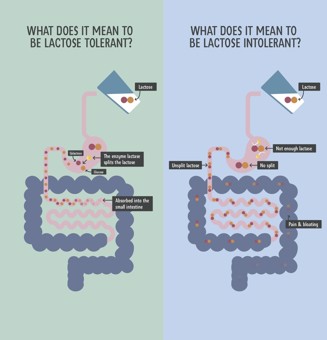
People who suffer from lactose intolerance have low levels of lactase in their digestive system. It’s not the same as being allergic to milk. Some people can still enjoy cheeses, yogurts and lactose free dairy.
Am I lactose intolerant? What are the symptoms of lactose intolerance? And what causes a dairy intolerance? These are questions that are frequently being asked on Google as more people are becoming aware of the condition. Let’s take a look at the facts about lactose and lactose intolerance.
Lactose is the naturally occurring sugar in all milk from mammals and it provides a natural, slightly sweet taste. It’s a sugar molecule made up of two smaller sugar molecules, glucose and galactose. For your body to digest lactose without problems, the two smaller molecules must first be split up by an enzyme called lactase. Glucose and galactose can then individually be absorbed in the small intestine with no discomfort.

What is lactose intolerance?
A person who suffers from lactose intolerance, also known as lactose maldigestion or dairy intolerance, has low levels of lactase.
In the absence of sufficient lactase, more of the lactose will pass unsplit into the large intestine, where gut bacteria will start to break it down. As a side effect of the bacteria’s process, some people get unpleasant symptoms such as stomach pain or bloating. Some people with lactose intolerance can consume very little dairy before experiencing symptoms while others can consume more.
Being lactose intolerant is not the same as being allergic to milk and it doesn’t necessarily mean that you have to avoid dairy completely. Some people with lactose intolerance may decide to avoid regular milk, but continue to enjoy many types of cheeses and yogurts that have lower lactose levels.
If you suffer from lactose intolerance, you can enjoy lactose-free dairy products where the lactose is partly removed and/or split. This way you will still get the beneficial nutrients from milk.
Read more about lactose-free dairy products:
If you decide to exclude dairy completely from you diet, it’s important that you replace the nutrients that you normally get from milk with plenty of natural food sources such as green vegetables, almonds, eggs, beans, lentils and fish. It’s a good idea to consult a doctor or dietician on diets and the need for supplements.
Read more about nutrition in milk
What are the lactose intolerance signs?
The typical symptoms of lactose intolerance can be:
- Stomach pain
- Bloating
- Gas
- Diarrhoea
The lactose intolerance signs can occur from 15 minutes to six hours after consuming products containing lactose. It’s usually harmless, but can obviously be quite uncomfortable. Some people also think that lactose intolerance causes constipation, however, it is not commonly associated in research.
You should talk to your doctor if you experience symptoms of lactose intolerance. There are different tests that can help diagnose if you are in fact lactose intolerant.
Lactose intolerance in babies, toddlers and older children
Lactose is the milk sugar and the most important carbohydrate source in milk. In breast milk, and the majority of infant formulas, 40% of the energy content comes from lactose. Breaking down lactose in the digestive system is therefore particularly important for infants. Fortunately, lactose intolerance in babies or toddlers is very uncommon. But it does occur.
While the majority of children of European descent maintain their ability to digest lactose in their teens and throughout adulthood, children of many other ethnicities often produce less and less lactase as they grow older and many eventually become lactose intolerant. This loss of ability to digest lactose does not start to decline before the age of 3-5 years.
The symptoms of lactose intolerance in infants, toddlers and older children are often the same as in adults: stomach pain, bloating, gas or diarrhoea – but also vomiting. These symptoms are, however, not uncommon among infants and don’t necessarily have to be signs of lactose intolerance. If you think your baby has lactose intolerance, you should contact your doctor in order get your infant properly diagnosed and get advice on the diet.
How many people are lactose intolerant?
It is estimated that around 65% of the worlds’ population is lactose intolerant to some degree. However, the rates are unevenly distributed across the world’s regions for reasons that are related to genetic evolution and to the cultural history of dairy farming and domestication of cows, goats and sheep.
In some areas in Europe, for example the UK and Scandinavia, where dairy has been part of the diet for thousands of years, only around 5% of the population are lactose intolerant. The same goes for Americans of European descent. In some communities in Asia, however, up to 90% of the population are lactose intolerant.
Milk allergy vs lactose intolerance - is it the same?
No, it's not. If you suffer from a milk allergy, you can’t tolerate milk protein and should avoid any kind of milk or dairy products.
If you are lactose intolerant and wish to have dairy in your diet, it is an option to try lactose free dairy products. Or try smaller amounts of regular dairy products or stick to dairy products with naturally low lactose levels, such as hard or semi-hard yellow cheeses (less than 0,05g lactose per 100g cheese).